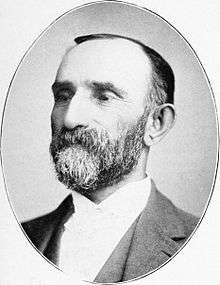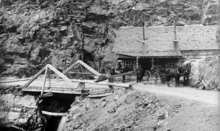Otto Mears



Otto Mears (May 3, 1840 – June 24, 1931) was a famous Colorado railroad builder and entrepreneur who played a major role in the early development of southwestern Colorado.[1][2]
Mears was known as the "Pathfinder of the San Juans" because of his road and railroad building projects through Colorado's San Juan Mountains in the late 19th Century.[3] He built hundreds of miles of toll roads in the rough terrain of the young state of Colorado,[4] notably the Million Dollar Highway over Red Mountain Pass, connecting Silverton to Ouray.
Early life and education
Born in Estonia formerly part of Russia of Jewish parentage to a Russian mother and a British father, Otto Mears was orphaned when young. He was sent as a boy to the United States to live with relatives who had emigrated there, and sailed to San Francisco.
Mears served in the California Volunteer Infantry during the Civil War.
Career
Later Mears worked the gold fields of California before settling in Colorado, where he would make his name. He initially settled in Conejos County in Colorado Territory, but soon moved to Saguache, Colorado, then to the San Juans.[5]
A wheat farmer in Saguache, Mears first built a road over Poncha Pass to gain access to the flour mill at Nathrop, which served the Leadville market. Mears told a story many times in his life that his decision to become a road builder followed an encounter with William Gilpin, former Territorial Governor of Colorado, on Poncha Pass while struggling to bring his flour to market over the poorly built road.[6] He applied to the Colorado legislature for toll road charters for his roads and built the roads in conformations and at grades suitable for railways. His routes over Poncha Pass and Marshall Pass were purchased for road beds by the Denver and Rio Grande railway.[5]
Mears built several railroads during his 91 years, including the Rio Grande Southern Railroad from Durango to Ridgway, the Silverton Railroad, and the Silverton Northern Railroad. Several of his railroads were narrow gauge. From 1888 to 1892, Mears issued special railroad passes to dignitaries and friends to allow them to ride free on any of his lines.[7] Some of these rare passes were made of silver or gold and are now highly prized collectors' items.
In 1876, the state legislature selected Mears as one of Colorado's three presidential electors supporting Republican Rutherford B. Hayes.[8] In the 1880s, Mears was elected to the Colorado legislature. The panic of 1893 reduced the value of his investments. He had to sell much property and lost control of his railroad holdings.[9]
Mears moved to the East Coast and became involved in railroad and manufacturing ventures there.[9] One of his most successful railroads on the east coast was the Chesapeake Beach Railway, which ran between Washington DC and southern Maryland.
The dome of the Colorado State Capitol building was originally covered in copper. After the weather tarnished the copper sheathing, Mears suggested covering the dome with gold. He persuaded the Colorado Mining Association to donate 200 ounces of gold for the project, and by 1908, the dome's first gilding was complete.[10][11]
Otto Mears died on June 24, 1931 in Pasadena, California.[4]
References
- ↑ Stone (1919), pp. 640-641.
- ↑ "Colorado State Archives: Colorado State Capitol Virtual Tour: Otto Mears". 20 June 2003. Retrieved 18 April 2008.
- ↑ Williamson, Ruby G. "Otto Mears Pathfinder of the San Juan: His Family and Friends" (Gunnison, 1981).
- 1 2 Strong (1988), p. 2.
- 1 2 "Otto Mears "Pathfinder of the San Juans"". Ghostdepot.com. Retrieved August 11, 2011.
- ↑ Elise Thatcher (September 18, 2012). "The Pathfinder of the San Juans". Colorado Matters. Colorado Public Radio.
- ↑ Strong (1988).
- ↑ Hall (1895), p. 510.
- 1 2 Hunt (1960), pp. 306-307.
- ↑ "Colorado State Archives: Colorado State Capitol Virtual Tour: The Gold Dome". 19 May 2005. Retrieved 18 April 2008.
- ↑ Waldrep, Luann (16 April 2008). "Otto Mears, 1840-1931". Denver Post. p. 12D.
Works Cited
- Baker, James H., ed. (1927). History of Colorado: Biographical. Vol. V. LeRoy R. Hafen, Assc. Ed.; State Historical and Natural History Society of Colorado. Denver, CO: Linderman Co.
- Hall, Frank (1895). History of the State of Colorado. Vol. IV. Chicago, IL: Blakely Printing Co.
- Hunt, Inez; Draper, Wanetta W. (1960). "Otto Mears, Little Man with the Giant Stride". To Colorado's Restless Ghosts. Denver, CO: Sage Books.
- Stone, Wilbur Fiske (1919). History of Colorado, Illustrated. Vol. IV. Chicago, IL: The S. J. Clarke publishing company.
- Strong, William K. (1988). The Remarkable Railroad Passes of Otto Mears. Silverton, CO: San Juan County Book Co. ISBN 0-9608000-6-9.
External links
| Wikimedia Commons has media related to Otto Mears. |